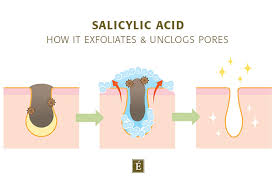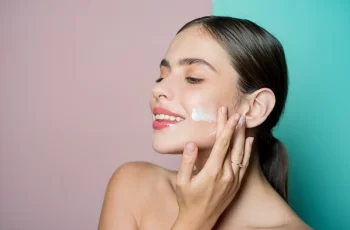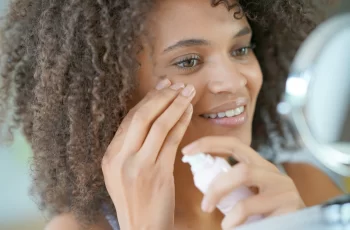Does Salicylic Acid Fight Acne?
If you have oily, acne-prone skin, you may have heard of the popular skincare ingredient salicylic acid. It’s known for penetrating deep into the pores and removing excess sebum, dirt, bacteria, and other impurities.
A member of the beta-hydroxy acid family of chemical exfoliants, salicylic acid also works on the outer surface of the skin to remove accumulated dead skin cells, dirt, and debris. All of this impurity can often develop into a host of issues, from blemishes, acne, skin flakes, to a dull, lackluster complexion. If you want to learn more about how salicylic acid works on the skin and how it can positively impact the overall look and feel of your complexion, you can read the dedicated blog post “What is Salicylic Acid?”
Now let’s answer the question in today’s blog post: Is salicylic acid good for acne? So let’s dive in and find out more!
Does Salicylic Acid Cause More Acne?
In short: Yes, salicylic acid can cause more acne, but there are several factors that may contribute to it. Here are some examples of what may be causing the increase in acne flare-ups you’re experiencing.
You’re Using the Wrong Concentrate
Before you introduce the acid into your daily routine, you should focus on the concentration of BHA in the formula. To get a better idea of how effective your product is, you should check the ingredient list. If salicylic acid is one of the first five active ingredients listed, it indicates that an effective amount is present. This means that the BHA is helping to fight acne and breakouts. If you find yourself using a product that’s high in salicylic acid but isn’t having an effect on your skin, you may need to switch to a different, more effective formula.
You’re Not Using Enough
Salicylic acid generally requires that you introduce it into your daily routine slowly at first. Once your skin has built up a tolerance to the acid, you can use it more frequently, which can improve skin clarity and keep your skin barrier fully protected and functioning optimally.
This Ingredient Isn’t Right for You
If your breakouts and acne issues haven’t improved after using a salicylic acid product for more than 4 weeks, it could be a sign that the ingredients in the product aren’t right for you. You may want to consult a doctor or dermatologist to find another ingredient or product that can help you resolve your issues without causing an adverse reaction.
This Could Be a Sign It’s Working
Believe it or not, your acne may get worse before it gets better. Once you start using salicylic acid in your daily skincare routine, you’ll often find that your acne seems to get worse. While this may seem daunting, it’s a sign that the powerful BHA is working deep within the pores to remove excess sebum, bacteria, dirt, and debris. When all this “gunpowder” is pushed to the surface of the skin, it can lead to short-term breakouts of acne and pimples, but with regular use, this should slowly subside after 4 weeks.
How long does salicylic acid take to work?
As you can see (and I briefly answered this question in the previous section), it usually takes about 4 weeks to see noticeable changes in your skin tone and a reduction in active pimples and acne flare-ups. You may find that you see results faster, sometimes it takes longer depending on the severity of your breakouts, and the product will need to be used for about 6 to 8 weeks before you see noticeable improvements.
If you don’t see any noticeable improvements within this time, it may be a sign that you should see your doctor about alternative ingredients or products. I also recommend doing a 24-hour patch test before applying new products to your face to avoid reactions.
Which acid is best for acne?
Dermatologists and skin care experts consider salicylic acid to be the best acid for treating pimples and acne. There are more potent ingredients such as benzoyl peroxide that are very effective in fighting acne. However, many prefer salicylic acid, which comes in a variety of formulas, is simple and easy to incorporate into your daily routine.
Salicylic acid is found in over-the-counter products such as toners, cleansers and serums, usually in concentrations of 0.5% to 2%. For higher concentrations of the acid, opt for a chemical peel or professional facial, which contains a medicinal percentage of the acid. Chemical peels or facials are considered the best starting point for clear skin.
Can I use salicylic acid every day?
Yes, it is considered safe to use salicylic acid every day once your skin has developed a tolerance to the active acid. It is best to start by using salicylic acid products only 2-3 times a week, preferably at night, as salicylic acid products are known to increase the skin’s sensitivity to light, which increases the risk of sun damage to the face. To avoid this, you should apply a sun protection factor every day to provide your skin with extra protection. If you find that your skin remains comfortable after using salicylic acid 2-3 times a week, you can start using it daily. For more information on daily use of salicylic acid, see our dedicated blog post.
Is salicylic acid good for acne scars?
Yes, it is. Due to the exfoliating properties of the acid, you will notice that the pigmentation of the remaining acne scars will decrease and become less visible to the naked eye. If you want to remove acne scars and dark spots quickly and effectively, your best option is to consult a professional who can provide you with a range of chemical peels and facials.
Here you can learn more about salicylic acid and whether it is good for acne. As I mentioned before, you should consult a doctor before trying any new formula on your skin to avoid negative reactions. If you have any other questions, don’t forget to follow us on Instagram.
DQH Knowledge drop: In your 20s, your skin cell turnover decreases. (Cell turnover is a key component in keeping your skin youthful.) You know what else slows down? Your collagen production. Starting in your 20s, collagen decreases by about 1 percent per year. Should you want to prevent fine lines and wrinkles, start by eliminating behaviors that contribute to premature aging. “If it’s bad for you, it’s bad for your skin,” says dermatologist Michel Somenek.
“Cigarette smoking reduces blood flow to the skin and causes premature wrinkling and a dull skin texture. Making the repeated pursed motion to inhale can also cause smoker’s lines. Alcohol and recreational drugs are toxins for the skin that damage its cellular structure and DNA,” Somenek tells us. “The faster you eliminate vices while you are young, the better chance your skin and body have to recuperate.” Also, adopting an anti-aging routine in your 20s is key. After all, the best offense is a good defense. We spoke to Somenek and experts Joshua Ross and Audrey Kunin to find out more.
Keep reading for the best anti-aging products for your 20s, according to skincare professionals.
Sunscreen
“We all know that the sun is the number one cause of skin aging and starting the prevention in your 20s is very important,” Ross says. “The majority of your sun damage won’t start to appear until you’re in your 30s, so don’t wait until you see it surface or you’ll be behind the curve. Stay ahead of it with a good-quality zinc-based sunscreen worn daily.”
Farmacy Green Defense Daily Mineral Sunscreen
An invisible sunscreen with SPF 30, plus botanical extracts meant to protect skin with tons of antioxidants. Bonus: It’s clean and fine to use under makeup.
Bareminerals Complexion Rescue™ Tinted Moisturizer Broad Spectrum SPF 30
Although we recommend you use your SPF and moisturizer separately, we also understand moments when you don’t have time or energy for that extra step. For those times, this bareMinerals moisturizer is a great thing to have on hand.
Vitamin C Serum
“A great introduction to anti-aging is to start with a vitamin C serum in your morning skincare routine,” Ross says. “It’s a powerful antioxidant that will neutralize free radicals and brighten the skin.” He adds that it’s a great way to counteract the effects of the sun’s harmful rays, which, as previously mentioned, are among the biggest causes of premature aging.
Drunk Elephant C-Firma™ Vitamin C Day Serum
The Drunk Elephant C-Firma is a lightweight serum that promises to give skin a glow by combining the brightening powers of vitamin C with ferulic acid, l-ascorbic acid, and vitamin E. The included sodium hyaluronate is meant to replace hydration loss, so you shouldn’t have to deal with any irritation.
Sunday Riley C.E.O. Rapid Flash Brightening Serum
This potent serum is jam-packed with vitamin C (15 percent, to be exact), which means it’s a potential superstar at both brightening skin and dousing it in antioxidants.
Peptides
Using peptides on your skin has many benefits, says Somenek. “The skin barrier is what defends the body against pollution, UV rays, bacteria, and toxins. It can be damaged by several everyday factors. Using topical peptides aids in building a stronger barrier,” he says. “Peptides comprise elastic fibers, which are a type of protein. These fibers help to make skin appear taut and firm. Peptides can also help repair damaged skin, relieve inflammation, and even out skin tone. Some peptides can kill acne-causing bacteria that is common in 20-somethings.”
Kunin agrees, saying, “Peptides are an excellent entry point for supporting collagen.” She recommends looking for face and eye treatments that contain these collagen-boosting powerhouses.
Charlotte Tilbury Magic Eye Rescue Cream
This Charlotte Tilbury super-emollient eye cream has a base of coconut oil and shea butter (read: it’s incredibly hydrating). Botanicals plus peptides are meant to help reduce dark circles and boost collagen, respectively.
This creamy moisturizer serves up potent collagen-boosting peptides and pycnogenol, and antioxidant-rich vitamin C. “Instead of sitting on top of the skin, peptides penetrate the outer layer so they go deep. The ‘signals’ they send tell the cells to produce elastin and collagen, which are needed for youthful-looking skin,” explains Somenek.
At-Home Peel Pads
Remember that skin cell turnover fiasco we talked about earlier? One way to help support it is by exfoliating. “Exfoliation is important to help keep skin fresh and luminous,” Kunin says. She recommends using at-home peel pads as an easy and effective way to exfoliate.
“The goal in your 20s is to fight the slowing pace of cell turnover. It is wise to use products that gently exfoliate, yet still remove oil and other impurities. Products that have Alpha Hydroxy Acids (AHA) or Beta Hydroxy Acids (BHA) are a good choice.”
According to Somenek, you should only exfoliate two to three times a week. “People of all ages are guilty of over-exfoliating and that can be too much of a good thing,” he says.
Dermadoctor Kakadu C Intensive Vitamin C Peel Pad
A few swipes of this Derma Doctor powerful peel pad promise to leave your skin glowing and smooth, thanks to the seven (yes, seven) types of chemical exfoliants, including AHA and BHA. It also contains vitamin C via Kakadu plum extract for added brightening and antioxidant protection.
KEY INGREDIENTS Kakadu plum extract is sourced from the Kakadu plum, a fruit grown in northern Australia. It contains vitamin C, which restores the skin’s natural barrier, increases collagen production, and soothes irritation.
Dr. Dennis Gross Skincare Alpha Beta® Universal Daily Peel Pads
These are the gold standard of peel pads, with a cult following and over 900 five-star reviews on Sephora. They’re easy to use and contain a blend of anti-aging exfoliating acids.
Emollient Night Cream
“In your 20s, you need to start upping the hydration in your skincare routine. You may have been cautious of over-moisturizing because of acne in your teens, but as you enter your 20s, your skin transitions and becomes drier,” Ross says. “I recommend an emollient night cream added into your evening skincare regimen.”
“Twenty-somethings need to make sure that they are not using creams that will clog their pores and cause excess oil production,” says Somenek. Opt for non-comedogenic products.
Cerave Skin Renewing Night Cream
One great choice is the CeraVe Skin Renewing Night Cream, which is a non-comedogenic night cream that leaves skin soft and glowy. It combines the moisturizing powers of ceramides and hyaluronic acid.
RoC Retinol Correxion Max Hydration Creme
“The best night cream ingredients contain retinol, benzoyl peroxide, and/or salicylic acid or hyaluronic acid. The goal is to moisturize, yet remove excess oil,” says Somenek. This Roc Retinol Correxion cream fits the bill as it contains both hyaluronic acid and retinol so it promises to moisturize while also being non-comedogenic.



